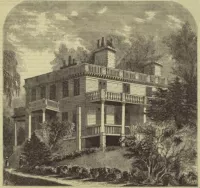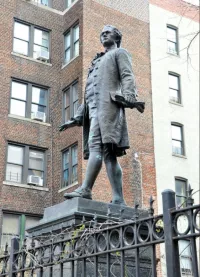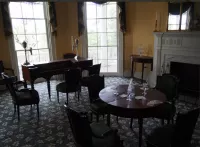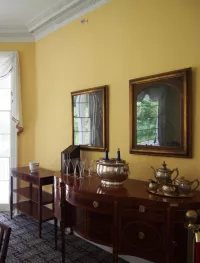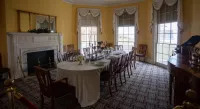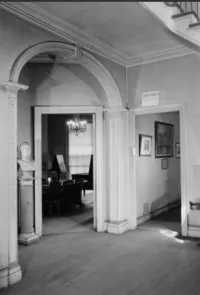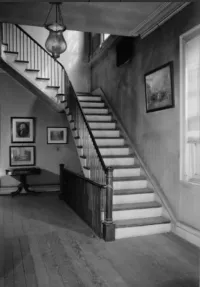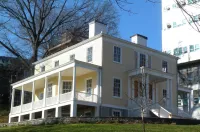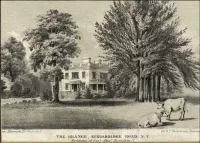Share what you know,
and discover more.
Share what you know,
and discover more.
Mar 14, 2023
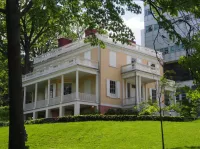
-

- Charmaine Bantugan
Hamilton Grange
Completed in 1802, for Founding Father Alexander Hamilton (1755-1804) and his wife, Elizabeth Schuyler (1757-1854). Officially known today as "Hamilton Grange National Memorial," it is one of only three former country mansions from the Federal period left standing on Manhattan - the other two being the Gracie Mansion and the Morris-Jumel Mansion. Having been moved twice, today it is again surrounded by parkland on what had been part of the original Hamilton estate. It has been beautifully restored to its original glory and is open to the public as a house museum - finding particular fame now being the home of the star of the hit broadway show, "Hamilton". Born in the West Indies, Hamilton came to America to study as a guest of the Livingstons at Liberty Hall. He rose to prominence during the Revolution as chief aide-de-camp to George Washington (1732-1799) and today he is easily recognized as the man whose face appears on the ten-dollar bill. A Founding Father who created the new nation's financial system, he was 1st U.S. Secretary of the Treasury and is credited as a founder of the U.S. Coast Guard, the Bank of New York, the New York Post and the now defunct Federalist Party. His wife, Elizabeth, was a leading socialite who grew up at the Schuyler Mansion. In 1798, the Hamiltons rented a house for the summer in upper Manhattan with Elizabeth's brother-in-law - the entertainingly corrupt John Barker Church - and his family. But, it was the view of the Hudson from Rooka Hall that enticed them to build where they did. In 1799, Hamilton paid just short of $3,650 to Samuel Bradhurst III (1749-1826), of Pinehurst, for 20-acres on Harlem Heights. The following year, Hamilton persuaded another great friend, Jacob Schieffelin III, the owner of Rooka Hall, to part with 15-acres of adjoining land for $4,000, on which Hamilton built his country home. Siting His Seat Hamilton's newly acquired 35-acre estate combined sweeping views over the Harlem Valley, Harlem River, Hudson River and East River. He sited the mansion at what today would be 143rd Street and Convent Avenue, sitting directly between the East and Hudson Rivers. Set amid woods and numerous streams that led down to a large duck pond, it stood on a rocky outcrop at the top of a 200-foot incline overlooking the countryside. Taking inspiration from the Gracie Mansion, Hamilton employed architect John McComb, Jr. to design his new home, while Ezra Weeks would build it with timber gifted from Hamilton's father-in-law, Philip Schuyler. During construction, with his usual zeal Hamilton worked closely alongside McComb involving himself in every detail. Its completion cemented his place in New York's aristocratic society: he had his wife's name, his achievements and lineage; and, now an elegant country seat within a fashionable sphere of the city. "A Sweet Asylum from Care and Pain" Hamilton's new home stood two stories high over a raised basement. Its timber exterior measures roughly 50-by-50 feet and it's flanked on both sides by broad Tuscan-style porches. He named his country estate "Grange" which became referred to as "The Grange". His father, James Hamilton (1718-1799), had grown up at "Grange" in Ayrshire, Scotland, which is better known today as Kerelaw Castle and was the ancestral seat of the Hamiltons of Cambuskeith and/or Grange from 1655 to 1787. Behind the entrance hall and beyond an arch, the interior features two octagonal rooms (the drawing room and dining room) joined by folding doors inlaid with mirrors. The mirrors - likely inspired by those he had seen at the Bingham Mansion - 'delighted' Hamilton by capturing the reflection of the landscape through the floor-to-ceiling bay windows. The inspiration for the octagonal shape of these rooms is usually accredited to the drawing room at the nearby Morris-Jumel Mansion, but he was a well-travelled man and would have seen many others of the like in Boston and Philadelphia etc. On the top floor, there were six bedrooms while the basement contained the kitchen, offices and servant's rooms. In the grounds, a grove of 13-American sweet-gum trees were planted as saplings taken from Mount Vernon. Chosen for their star-shaped leaves, they represented the 13 original states of America. Building and furnishing Grange had nearly bankrupt Hamilton; but, it was worth it, and on completion he referred to his country home as, "a sweet asylum from care and pain". At Home with the Hamiltons Alexander and Eliza Hamilton entertained many of the best known figures of the day in post-Revolutionary America, such as: George Washington; Joseph Bonaparte, then resident at Point Breeze; James Fenimore Cooper, of Otsego Hall; and, the Marquis de Lafayette. As an escape from politics, Hamilton enjoyed the solace of hunting and fishing on his grounds and after a weekend at the Grange, James Kent (1763-1847) observed, He never appeared before so friendly and amiable… He treated me with a minute attention that I did not suppose he knew how to bestow. His manners were also very delicate and chaste… He appeared in his domestic state the plain, modest, and affectionate father and husband. Just two years after the house was completed, Hamilton was notoriously shot dead in a duel with Aaron Burr (1756-1836), who promptly went into hiding at Lindenwald under the protection of William Van Ness. Unbeknownst to his widow, Hamilton died with debts to the tune of some $60,000, which ordinarily would have left her and their seven children destitute. But, led by Gouverneur Morris (1752-1816), over one hundred of his friends secretly clubbed together to raise $80,000 which they held in trust for Elizabeth. In 1805, 28 of these men, this time led by Archibald Gracie (1755-1829), "the old gentleman (with) the soul of a prince," purchased the mansion and estate for $30,500 before selling it back to Elizabeth for just $15,000, allowing her and her children to remain here. By 1833, Eliza was 76-years old and with the residue from the trust running low (the secret of its origins remained that way until long after her death), it was time to downsize. That year, she sold the Grange for $25,000 to Thomas E. Davis (1785-1878), who in turn sold her son - Alexander Hamilton Jr. (1786-1875) - one of his downtown properties at 4 St. Mark's Place for $15,500. He and Eliza lived there (in what is now known as the Hamilton-Holly House) until 1848 when she made her final move to Washington D.C., where she died. Davis & Pearson (1833-1842) In his time, Thomas E. Davis was one of Manhattan's most prominent real estate developers. Unsurprisingly then, just two years later (1835) he sold Grange on for a healthy profit ($56,511, more than double what he paid for it) to Isaac Green Pearson (1791-1874), "a large-hearted, benevolent gentleman" from Boston who developed LeRoy Place in 1827, home to many of the city's finest, including Governor Joseph Yates. The Ward Family (1842-1876) In 1842, Pearson was declared bankrupt and the house was repossessed by the banking house of Prime, Ward & King. Two years later, it was sold to tea merchant William Greene Ward (1802-1848), the uncle of Sam Ward, the senior partner of Prime, Ward & King who married Emily Astor and later perfected the art of political lobbying, gaining the nickname the "King of the Lobby". Sam was the brother of the equally well-known social activist and abolitionist Julia Ward Howe, author of the "Battle Hymn of the Republic," and their sister, Anne, was married to a grandson of Joseph-Napoleon Bonaparte. In November, 1844, William G. Ward's silver-tongued nephew, Sam Ward, obtained use of the Grange for the honeymoon of his sister, Louisa Cutler Ward (1823-1897). Her (first) husband was the talented sculptor Thomas Gibson Crawford (1814-1857) whose 20-foot bronze "Statue of Freedom" still crowns the dome of the U.S. Capitol today. William Ward died in 1848, but his widow, Abby Hall (1802-1886), their children, and grandchildren continued to use the Grange as their family summer home up until 1876. By then, Mrs Ward had fallen into debt and it was repossessed by the Emigrant's Bank. Decline & First Move (1889) By this time, what little was left of rural Manhattan was in the process of being bought up and developed. In 1879, the Emigrant's Bank sold the Grange for $312,500 to architect-cum-developer Anthony Mowbray (d.1896), who turned it over for a swift profit just one month later to a business associate. The new buyer was William H. de Forest, a wealthy silk merchant and collector of art who became a millionaire real estate developer before ending up in a mental institute. De Forest and his son carved up the old Hamilton estate into 300-lots, which they either sold or developed themselves. In 1889, to save it from demolition, Amos Cotting (1828-1889), a successful merchant and Wall Street broker who owned much of the property around, purchased the mansion and donated it to St. Luke's Church on the condition it was relocated next to it. So, for the first time, the Grange was picked up, moved 250-feet and squeezed into its new home at 287 Convent Avenue, where it was used as a chapel. House Museum & Second Move (2008) to its Present Location In 1924, the Grange was purchased by the American Scenic & Historic Preservation Society. They opened it as a house museum, but it continued to fall into disrepair. It was designated a National Historic Landmark in 1960, but when it was purchased two years later by the National Park Service its cramped, urban location was deemed inappropriate for its survival. After decades of fund-raising, cutting through bureaucratic red tape, and bypassing various objections, the Grange went on the move again in 2008. Known officially today as the "Hamilton Grange National Memorial" its present location is next to the City College of the City University of New York within St. Nicholas Park on land that was once part of the Hamilton estate. Beautifully restored to its original splendor and once again open to the public as a house museum, since 2015 it has seen an influx of interest following the award-winning success of Lin-Manuel Miranda's Broadway hit Hamilton, a musical inspired by Ron Chernow's biography.
Hamilton Grange
Completed in 1802, for Founding Father Alexander Hamilton (1755-1804) and his wife, Elizabeth Schuyler (1757-1854). Officially known today as "Hamilton Grange National Memorial," it is one of only three former country mansions from the Federal period left standing on Manhattan - the other two being the Gracie Mansion and the Morris-Jumel Mansion. Having been moved twice, today it is again surrounded by parkland on what had been part of the original Hamilton estate. It has been beautifully restored to its original glory and is open to the public as a house museum - finding particular fame now being the home of the star of the hit broadway show, "Hamilton". Born in the West Indies, Hamilton came to America to study as a guest of the Livingstons at Liberty Hall. He rose to prominence during the Revolution as chief aide-de-camp to George Washington (1732-1799) and today he is easily recognized as the man whose face appears on the ten-dollar bill. A Founding Father who created the new nation's financial system, he was 1st U.S. Secretary of the Treasury and is credited as a founder of the U.S. Coast Guard, the Bank of New York, the New York Post and the now defunct Federalist Party. His wife, Elizabeth, was a leading socialite who grew up at the Schuyler Mansion. In 1798, the Hamiltons rented a house for the summer in upper Manhattan with Elizabeth's brother-in-law - the entertainingly corrupt John Barker Church - and his family. But, it was the view of the Hudson from Rooka Hall that enticed them to build where they did. In 1799, Hamilton paid just short of $3,650 to Samuel Bradhurst III (1749-1826), of Pinehurst, for 20-acres on Harlem Heights. The following year, Hamilton persuaded another great friend, Jacob Schieffelin III, the owner of Rooka Hall, to part with 15-acres of adjoining land for $4,000, on which Hamilton built his country home. Siting His Seat Hamilton's newly acquired 35-acre estate combined sweeping views over the Harlem Valley, Harlem River, Hudson River and East River. He sited the mansion at what today would be 143rd Street and Convent Avenue, sitting directly between the East and Hudson Rivers. Set amid woods and numerous streams that led down to a large duck pond, it stood on a rocky outcrop at the top of a 200-foot incline overlooking the countryside. Taking inspiration from the Gracie Mansion, Hamilton employed architect John McComb, Jr. to design his new home, while Ezra Weeks would build it with timber gifted from Hamilton's father-in-law, Philip Schuyler. During construction, with his usual zeal Hamilton worked closely alongside McComb involving himself in every detail. Its completion cemented his place in New York's aristocratic society: he had his wife's name, his achievements and lineage; and, now an elegant country seat within a fashionable sphere of the city. "A Sweet Asylum from Care and Pain" Hamilton's new home stood two stories high over a raised basement. Its timber exterior measures roughly 50-by-50 feet and it's flanked on both sides by broad Tuscan-style porches. He named his country estate "Grange" which became referred to as "The Grange". His father, James Hamilton (1718-1799), had grown up at "Grange" in Ayrshire, Scotland, which is better known today as Kerelaw Castle and was the ancestral seat of the Hamiltons of Cambuskeith and/or Grange from 1655 to 1787. Behind the entrance hall and beyond an arch, the interior features two octagonal rooms (the drawing room and dining room) joined by folding doors inlaid with mirrors. The mirrors - likely inspired by those he had seen at the Bingham Mansion - 'delighted' Hamilton by capturing the reflection of the landscape through the floor-to-ceiling bay windows. The inspiration for the octagonal shape of these rooms is usually accredited to the drawing room at the nearby Morris-Jumel Mansion, but he was a well-travelled man and would have seen many others of the like in Boston and Philadelphia etc. On the top floor, there were six bedrooms while the basement contained the kitchen, offices and servant's rooms. In the grounds, a grove of 13-American sweet-gum trees were planted as saplings taken from Mount Vernon. Chosen for their star-shaped leaves, they represented the 13 original states of America. Building and furnishing Grange had nearly bankrupt Hamilton; but, it was worth it, and on completion he referred to his country home as, "a sweet asylum from care and pain". At Home with the Hamiltons Alexander and Eliza Hamilton entertained many of the best known figures of the day in post-Revolutionary America, such as: George Washington; Joseph Bonaparte, then resident at Point Breeze; James Fenimore Cooper, of Otsego Hall; and, the Marquis de Lafayette. As an escape from politics, Hamilton enjoyed the solace of hunting and fishing on his grounds and after a weekend at the Grange, James Kent (1763-1847) observed, He never appeared before so friendly and amiable… He treated me with a minute attention that I did not suppose he knew how to bestow. His manners were also very delicate and chaste… He appeared in his domestic state the plain, modest, and affectionate father and husband. Just two years after the house was completed, Hamilton was notoriously shot dead in a duel with Aaron Burr (1756-1836), who promptly went into hiding at Lindenwald under the protection of William Van Ness. Unbeknownst to his widow, Hamilton died with debts to the tune of some $60,000, which ordinarily would have left her and their seven children destitute. But, led by Gouverneur Morris (1752-1816), over one hundred of his friends secretly clubbed together to raise $80,000 which they held in trust for Elizabeth. In 1805, 28 of these men, this time led by Archibald Gracie (1755-1829), "the old gentleman (with) the soul of a prince," purchased the mansion and estate for $30,500 before selling it back to Elizabeth for just $15,000, allowing her and her children to remain here. By 1833, Eliza was 76-years old and with the residue from the trust running low (the secret of its origins remained that way until long after her death), it was time to downsize. That year, she sold the Grange for $25,000 to Thomas E. Davis (1785-1878), who in turn sold her son - Alexander Hamilton Jr. (1786-1875) - one of his downtown properties at 4 St. Mark's Place for $15,500. He and Eliza lived there (in what is now known as the Hamilton-Holly House) until 1848 when she made her final move to Washington D.C., where she died. Davis & Pearson (1833-1842) In his time, Thomas E. Davis was one of Manhattan's most prominent real estate developers. Unsurprisingly then, just two years later (1835) he sold Grange on for a healthy profit ($56,511, more than double what he paid for it) to Isaac Green Pearson (1791-1874), "a large-hearted, benevolent gentleman" from Boston who developed LeRoy Place in 1827, home to many of the city's finest, including Governor Joseph Yates. The Ward Family (1842-1876) In 1842, Pearson was declared bankrupt and the house was repossessed by the banking house of Prime, Ward & King. Two years later, it was sold to tea merchant William Greene Ward (1802-1848), the uncle of Sam Ward, the senior partner of Prime, Ward & King who married Emily Astor and later perfected the art of political lobbying, gaining the nickname the "King of the Lobby". Sam was the brother of the equally well-known social activist and abolitionist Julia Ward Howe, author of the "Battle Hymn of the Republic," and their sister, Anne, was married to a grandson of Joseph-Napoleon Bonaparte. In November, 1844, William G. Ward's silver-tongued nephew, Sam Ward, obtained use of the Grange for the honeymoon of his sister, Louisa Cutler Ward (1823-1897). Her (first) husband was the talented sculptor Thomas Gibson Crawford (1814-1857) whose 20-foot bronze "Statue of Freedom" still crowns the dome of the U.S. Capitol today. William Ward died in 1848, but his widow, Abby Hall (1802-1886), their children, and grandchildren continued to use the Grange as their family summer home up until 1876. By then, Mrs Ward had fallen into debt and it was repossessed by the Emigrant's Bank. Decline & First Move (1889) By this time, what little was left of rural Manhattan was in the process of being bought up and developed. In 1879, the Emigrant's Bank sold the Grange for $312,500 to architect-cum-developer Anthony Mowbray (d.1896), who turned it over for a swift profit just one month later to a business associate. The new buyer was William H. de Forest, a wealthy silk merchant and collector of art who became a millionaire real estate developer before ending up in a mental institute. De Forest and his son carved up the old Hamilton estate into 300-lots, which they either sold or developed themselves. In 1889, to save it from demolition, Amos Cotting (1828-1889), a successful merchant and Wall Street broker who owned much of the property around, purchased the mansion and donated it to St. Luke's Church on the condition it was relocated next to it. So, for the first time, the Grange was picked up, moved 250-feet and squeezed into its new home at 287 Convent Avenue, where it was used as a chapel. House Museum & Second Move (2008) to its Present Location In 1924, the Grange was purchased by the American Scenic & Historic Preservation Society. They opened it as a house museum, but it continued to fall into disrepair. It was designated a National Historic Landmark in 1960, but when it was purchased two years later by the National Park Service its cramped, urban location was deemed inappropriate for its survival. After decades of fund-raising, cutting through bureaucratic red tape, and bypassing various objections, the Grange went on the move again in 2008. Known officially today as the "Hamilton Grange National Memorial" its present location is next to the City College of the City University of New York within St. Nicholas Park on land that was once part of the Hamilton estate. Beautifully restored to its original splendor and once again open to the public as a house museum, since 2015 it has seen an influx of interest following the award-winning success of Lin-Manuel Miranda's Broadway hit Hamilton, a musical inspired by Ron Chernow's biography.
Mar 14, 2023
Hamilton Grange
Completed in 1802, for Founding Father Alexander Hamilton (1755-1804) and his wife, Elizabeth Schuyler (1757-1854). Officially known today as "Hamilton Grange National Memorial," it is one of only three former country mansions from the Federal period left standing on Manhattan - the other two being the Gracie Mansion and the Morris-Jumel Mansion. Having been moved twice, today it is again surrounded by parkland on what had been part of the original Hamilton estate. It has been beautifully restored to its original glory and is open to the public as a house museum - finding particular fame now being the home of the star of the hit broadway show, "Hamilton".Born in the West Indies, Hamilton came to America to study as a guest of the Livingstons at Liberty Hall. He rose to prominence during the Revolution as chief aide-de-camp to George Washington (1732-1799) and today he is easily recognized as the man whose face appears on the ten-dollar bill. A Founding Father who created the new nation's financial system, he was 1st U.S. Secretary of the Treasury and is credited as a founder of the U.S. Coast Guard, the Bank of New York, the New York Post and the now defunct Federalist Party. His wife, Elizabeth, was a leading socialite who grew up at the Schuyler Mansion.
In 1798, the Hamiltons rented a house for the summer in upper Manhattan with Elizabeth's brother-in-law - the entertainingly corrupt John Barker Church - and his family. But, it was the view of the Hudson from Rooka Hall that enticed them to build where they did. In 1799, Hamilton paid just short of $3,650 to Samuel Bradhurst III (1749-1826), of Pinehurst, for 20-acres on Harlem Heights. The following year, Hamilton persuaded another great friend, Jacob Schieffelin III, the owner of Rooka Hall, to part with 15-acres of adjoining land for $4,000, on which Hamilton built his country home.
Siting His Seat
Hamilton's newly acquired 35-acre estate combined sweeping views over the Harlem Valley, Harlem River, Hudson River and East River. He sited the mansion at what today would be 143rd Street and Convent Avenue, sitting directly between the East and Hudson Rivers. Set amid woods and numerous streams that led down to a large duck pond, it stood on a rocky outcrop at the top of a 200-foot incline overlooking the countryside.
Taking inspiration from the Gracie Mansion, Hamilton employed architect John McComb, Jr. to design his new home, while Ezra Weeks would build it with timber gifted from Hamilton's father-in-law, Philip Schuyler. During construction, with his usual zeal Hamilton worked closely alongside McComb involving himself in every detail. Its completion cemented his place in New York's aristocratic society: he had his wife's name, his achievements and lineage; and, now an elegant country seat within a fashionable sphere of the city.
"A Sweet Asylum from Care and Pain"
Hamilton's new home stood two stories high over a raised basement. Its timber exterior measures roughly 50-by-50 feet and it's flanked on both sides by broad Tuscan-style porches. He named his country estate "Grange" which became referred to as "The Grange". His father, James Hamilton (1718-1799), had grown up at "Grange" in Ayrshire, Scotland, which is better known today as Kerelaw Castle and was the ancestral seat of the Hamiltons of Cambuskeith and/or Grange from 1655 to 1787.
Behind the entrance hall and beyond an arch, the interior features two octagonal rooms (the drawing room and dining room) joined by folding doors inlaid with mirrors. The mirrors - likely inspired by those he had seen at the Bingham Mansion - 'delighted' Hamilton by capturing the reflection of the landscape through the floor-to-ceiling bay windows. The inspiration for the octagonal shape of these rooms is usually accredited to the drawing room at the nearby Morris-Jumel Mansion, but he was a well-travelled man and would have seen many others of the like in Boston and Philadelphia etc.
On the top floor, there were six bedrooms while the basement contained the kitchen, offices and servant's rooms. In the grounds, a grove of 13-American sweet-gum trees were planted as saplings taken from Mount Vernon. Chosen for their star-shaped leaves, they represented the 13 original states of America. Building and furnishing Grange had nearly bankrupt Hamilton; but, it was worth it, and on completion he referred to his country home as, "a sweet asylum from care and pain".
At Home with the Hamiltons
Alexander and Eliza Hamilton entertained many of the best known figures of the day in post-Revolutionary America, such as: George Washington; Joseph Bonaparte, then resident at Point Breeze; James Fenimore Cooper, of Otsego Hall; and, the Marquis de Lafayette. As an escape from politics, Hamilton enjoyed the solace of hunting and fishing on his grounds and after a weekend at the Grange, James Kent (1763-1847) observed,
He never appeared before so friendly and amiable… He treated me with a minute attention that I did not suppose he knew how to bestow. His manners were also very delicate and chaste… He appeared in his domestic state the plain, modest, and affectionate father and husband.
Just two years after the house was completed, Hamilton was notoriously shot dead in a duel with Aaron Burr (1756-1836), who promptly went into hiding at Lindenwald under the protection of William Van Ness. Unbeknownst to his widow, Hamilton died with debts to the tune of some $60,000, which ordinarily would have left her and their seven children destitute. But, led by Gouverneur Morris (1752-1816), over one hundred of his friends secretly clubbed together to raise $80,000 which they held in trust for Elizabeth.
In 1805, 28 of these men, this time led by Archibald Gracie (1755-1829), "the old gentleman (with) the soul of a prince," purchased the mansion and estate for $30,500 before selling it back to Elizabeth for just $15,000, allowing her and her children to remain here.
By 1833, Eliza was 76-years old and with the residue from the trust running low (the secret of its origins remained that way until long after her death), it was time to downsize. That year, she sold the Grange for $25,000 to Thomas E. Davis (1785-1878), who in turn sold her son - Alexander Hamilton Jr. (1786-1875) - one of his downtown properties at 4 St. Mark's Place for $15,500. He and Eliza lived there (in what is now known as the Hamilton-Holly House) until 1848 when she made her final move to Washington D.C., where she died.
Davis & Pearson (1833-1842)
In his time, Thomas E. Davis was one of Manhattan's most prominent real estate developers. Unsurprisingly then, just two years later (1835) he sold Grange on for a healthy profit ($56,511, more than double what he paid for it) to Isaac Green Pearson (1791-1874), "a large-hearted, benevolent gentleman" from Boston who developed LeRoy Place in 1827, home to many of the city's finest, including Governor Joseph Yates.
The Ward Family (1842-1876)
In 1842, Pearson was declared bankrupt and the house was repossessed by the banking house of Prime, Ward & King. Two years later, it was sold to tea merchant William Greene Ward (1802-1848), the uncle of Sam Ward, the senior partner of Prime, Ward & King who married Emily Astor and later perfected the art of political lobbying, gaining the nickname the "King of the Lobby". Sam was the brother of the equally well-known social activist and abolitionist Julia Ward Howe, author of the "Battle Hymn of the Republic," and their sister, Anne, was married to a grandson of Joseph-Napoleon Bonaparte.
In November, 1844, William G. Ward's silver-tongued nephew, Sam Ward, obtained use of the Grange for the honeymoon of his sister, Louisa Cutler Ward (1823-1897). Her (first) husband was the talented sculptor Thomas Gibson Crawford (1814-1857) whose 20-foot bronze "Statue of Freedom" still crowns the dome of the U.S. Capitol today.
William Ward died in 1848, but his widow, Abby Hall (1802-1886), their children, and grandchildren continued to use the Grange as their family summer home up until 1876. By then, Mrs Ward had fallen into debt and it was repossessed by the Emigrant's Bank.
Decline & First Move (1889)
By this time, what little was left of rural Manhattan was in the process of being bought up and developed. In 1879, the Emigrant's Bank sold the Grange for $312,500 to architect-cum-developer Anthony Mowbray (d.1896), who turned it over for a swift profit just one month later to a business associate. The new buyer was William H. de Forest, a wealthy silk merchant and collector of art who became a millionaire real estate developer before ending up in a mental institute.
De Forest and his son carved up the old Hamilton estate into 300-lots, which they either sold or developed themselves. In 1889, to save it from demolition, Amos Cotting (1828-1889), a successful merchant and Wall Street broker who owned much of the property around, purchased the mansion and donated it to St. Luke's Church on the condition it was relocated next to it. So, for the first time, the Grange was picked up, moved 250-feet and squeezed into its new home at 287 Convent Avenue, where it was used as a chapel.
House Museum & Second Move (2008) to its Present Location
In 1924, the Grange was purchased by the American Scenic & Historic Preservation Society. They opened it as a house museum, but it continued to fall into disrepair. It was designated a National Historic Landmark in 1960, but when it was purchased two years later by the National Park Service its cramped, urban location was deemed inappropriate for its survival. After decades of fund-raising, cutting through bureaucratic red tape, and bypassing various objections, the Grange went on the move again in 2008.
Known officially today as the "Hamilton Grange National Memorial" its present location is next to the City College of the City University of New York within St. Nicholas Park on land that was once part of the Hamilton estate. Beautifully restored to its original splendor and once again open to the public as a house museum, since 2015 it has seen an influx of interest following the award-winning success of Lin-Manuel Miranda's Broadway hit Hamilton, a musical inspired by Ron Chernow's biography.
Posted Date
Mar 14, 2023
Historical Record Date
Mar 14, 2023
Source Name
House Histree
Source Website
Delete Story
Are you sure you want to delete this story?


